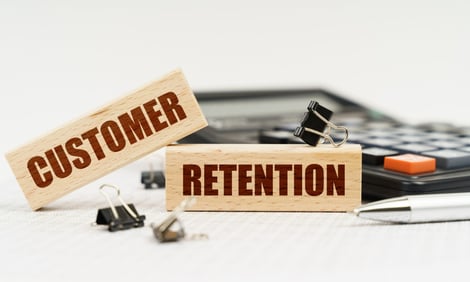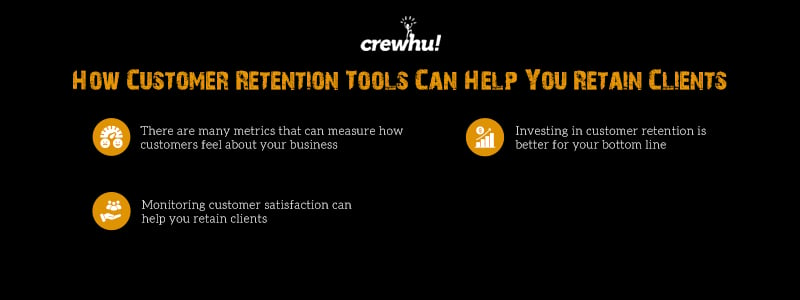How Customer Retention Tools Can Help You Retain Clients

The right software can help you monitor customer satisfaction, respond to any complaints or issues, and keep your clients coming back.
 How happy are your customers? How satisfied are they with your products, services, and customer experience? Monitoring customer satisfaction is essential because dissatisfied clients will be quick to jump to your competitors. This not only affects your bottom line in terms of lost sales, but you’ll have to spend even more money to acquire new customers.
How happy are your customers? How satisfied are they with your products, services, and customer experience? Monitoring customer satisfaction is essential because dissatisfied clients will be quick to jump to your competitors. This not only affects your bottom line in terms of lost sales, but you’ll have to spend even more money to acquire new customers.
In short, dissatisfaction leads to customer churn and reduced revenue. For this reason, you must constantly monitor your customer satisfaction score (CSAT) and employ customer retention tools and strategies to keep your clients coming back.
Metrics that help you monitor satisfaction
Customer satisfaction score (CSAT) is the gold standard metric for understanding how satisfied customers are with your services. It’s also the easiest to tabulate. Just ask your clients a simple question: “How satisfied were you with your experience?” To answer, the customer picks a number from a corresponding scale, which can be 1-3, 1-5, or 1-10.
High scores indicate that clients love your services and interactions, while low scores mean you need to put more effort into your customers’ experience. It’s just that simple.
While CSAT gives you a solid baseline score for your customers’ experience, it doesn’t tell you what you’re doing wrong. On its own, CSAT isn’t enough to provide you with the insights you need to improve your overall customer experience. That’s where these other metrics come in:
Customer satisfaction surveys
Like CSAT, these surveys monitor your customers’ satisfaction. But instead of asking them to rate their experience, you ask specific questions. You can conduct customer satisfaction surveys in several different ways:
- In-app surveys: To conduct an in-app survey, simply embed feedback questions on your website. In-app surveys generally have high response rates since they’re introduced while the respondent is already engaged with your business.
- Email surveys: Take advantage of your marketing emails to collect feedback. Embedding survey questions into emails is convenient, as it only takes one click for your readers to answer them.
- Post-service surveys: After an interaction with a client, send a post-service survey right away. This focuses on their satisfaction with the specific service or experience while it’s still fresh in their mind.
One-question surveys are especially useful as you can ask a question with a specific goal. For example, simply asking, “What can we do to improve your experience” can generate actionable feedback.
Net promoter score (NPS)
NPS is a customer satisfaction and loyalty metric obtained by asking customers how likely they are to recommend your business, product, or service to friends or family on a scale of 1-10. Respondents are categorized into:
- Promoters (score 9-10): These customers are happy and satisfied with the experience. They will keep buying and recommending you to others through word-of-mouth and referrals.
- Passives (score 7-8): They like your business and are satisfied but won’t go out of their way to refer you to others. These customers are also vulnerable to competitive offers.
- Detractors (score 0-6): Detractors are unhappy and unsatisfied customers.
To calculate your NPS, subtract the percentage of detractors from that of promoters. Your score can be as bad as -100 (if every customer is a detractor) or 100 (if there are no detractors).
High scores indicate that your customers are satisfied and more likely to return and recommend your business to others. Monitoring this metric can help you gauge satisfaction and develop strategies to convert passives into promoters.
Service level agreement (SLA)
SLA tracks the ticket resolution metrics that define the level of service your customers expect. Metrics to monitor include:
- Number of resolved tickets: Total number over a specified amount of time
- Average response time: The length of time from submission to first response
- Average resolution time: The length of time from submission to resolution
- First-time resolution rate: The number of tickets resolved within the first interaction
- Ticket escalation: The number of tickets escalated to higher-level agents
Monitoring SLA metrics helps determine whether you’re meeting the standards you set for yourself. You can then develop ways to reduce response and resolution times, resolve tickets without escalation, and increase customer satisfaction.
Customer effort score (CES)
CES focuses on the amount of effort it took customers to have their issues resolved. They answer this on a scale of 1 (very low effort) to 7 (very high effort). Of course, you want the lowest score possible, as high scores indicate less satisfaction and can result in reduced loyalty and customer churn.
High scores could result from long response times, lack of helpful information in self-service channels, or waiting to switch between several agents, all of which lead to customer frustration. Low customer effort, on the other hand, is likely to increase satisfaction with your customer service and encourage customers to return. And encouraging customers to return should be a key focus of your business.
How customer retention tools and systems can help you retain clients
With the right tools and strategies, you can boost customer retention by increasing satisfaction and turning one-time customers into loyal, repeat clients. Investing in customer retention tools makes it easy to build a pool of returning clients.
- Social monitoring tools like Google Alerts, Mention, and Hootsuite help monitor your brand’s social mentions to see what people are saying about you. You can also set alerts to receive notifications whenever a competitor is mentioned.
- Automation tools track customers throughout the sales funnel using real-time data. They increase retention by boosting engagement, fostering brand awareness, encouraging interaction, and converting customers. They include chatbots, live chats, and email automation.
- Gamification programs increase customer engagement by encouraging them to perform tasks or complete challenges and then rewarding them with points, badges, gift cards, and giveaways.
- Loyalty programs reward customers for doing business with you, sending referrals, sharing on social media, or leaving reviews. Whether it’s a VIP program or a points system, rewarding your customers for being loyal gives them a reason to keep coming back.
- Customer support systems build and improve satisfaction by providing great experiences whenever a customer contacts you. Positive interactions through ticketing systems, social media channels, live chat, or chatbots can increase retention through delightful experiences.
Using any or all of these retention tools helps boost customer loyalty and satisfaction by providing excellent experiences and positive interactions. At the same time, tracking your retention metrics allows you to monitor satisfaction and retain clients by building a profitable and positive relationship with your customers. Ultimately, you’ll not only reduce your customer acquisition costs but also increase customer spending.
Of course, it takes a lot of time and effort to monitor all of these metrics and develop responses to customer feedback. And that’s where Crewhu comes in.
Monitor satisfaction and retain clients with Crewhu
Crewhu helps monitor your metrics and collect customer feedback so you can focus on keeping your customers happy. For example, we can track metrics for your help desk and set up goal-based contests to improve any areas where your business is falling short. Book a Crewhu demo today and let us show you how we can help enhance your customer satisfaction, boost retention, and grow your bottom line.
Topics: customer retention, Monitor Customer Satisfaction, Track Your Metrics, Customer Retention Tools






